
James Hoard
-
Posts
632 -
Joined
-
Last visited
-
Days Won
1
Content Type
Profiles
Forums
Blogs
Gallery
Events
Store
Posts posted by James Hoard
-
-
"Common sense and logic in history would have had the Titanic still transporting passengers on voyages as it was deemed unsinkable in 1912."
Whatever that may be, logic and common sense it is not. On the contrary, logic and common sense would have suggested that bulk heads that did not go all the way to the ceiling were inherantly unstable and liable to sink a ship!
The facts regarding the issue on topic are these:
1) The purpose of the institution of the Order of Independence was to reward those who fought for the independence of the Arabs.
2) The award was originally intended for the above purpose, and not necessarily as a general award of merit (that happened under the Transjordan amirate)
3) General Ja'afar was the principal professional soldier and highest ranking officer in the Arab forces at the time.
4) The first class was being awarded to officers of the equivalent rank of full Colonel or equivalent.
5) After the loss of the Hijaz, he joined the Iraqi service, not Transjordan.
It would have been unusual in the extreme, under these circustamces, for him NOT to have received the award; from the sovereign who employed him to do exactly what the award was intended to recognise.
0 -
Perhaps one should simply use a little common sense and logic here.
Why would someone with such a leading role in the Arab War of Independence not receive that order from Hijaz, and have to wait until Transjordan was founded several years later.
0 -
His full name was Lieutenant-General Ja'afar Pasha el-Askieri an he is listed in Volume III (1929-1940) of Who Was Who. I do not have a copy to hand so cannot give you an extract. However, he was a former Turkish officer who joined the Arab Rebellion and was its leading professional commander, later joined the new Kingdom of Iraq and eventually rose to become Prime Minister. His British orders were GCVO (20.6.1933) and CMG (10.7.1918)
Cheers
James
0 -
This is true. I knew a chap who did his PHD work on the African armies colonial transitions (1920-1970). Sadly he died last year (and is the source of the Ugandan medals at Lowell), but this 'factoid' was one of his bugaboos.
Idi Amin made it up and who ever checked or cared to check?
I suppose Idi made it up and it got into the newspapers. His personal reading may not have taken him as far as the Great War, he would certainly have been aware of Prince George Chwa, since he was still Vice-President of the British Legion in Uganda in 1970. I think his first commission dates from May 1939, before the War started.
These 'factoids' about first commissions always interest me. Not so long ago I found a son of a former Black slave from Barbados. He served in the British forces during the American War of Independence, and ended his years with a commission as a Lieutenant Colonel in the New Brunswick or Nova Scotia Militia in 1782. Sadly, the man went out into the woods one day and was eaten by a bear.
0 -
"Chronology of Amin's military promotions
King's African Rifles
1961 First Ugandan Commissioned Officer, Lieutenant"
Not so.
Several Ugandan gentlemen, particularly from Bugandan Royal and noble families held commissions during the Great War and served in the East Africa campaign. The Kabaka of Buganda ended the War as a a Captain. His eldest son, Prince George, served as a Captain during WW2 and headed the Ugandan chaper of the British Legion and various ex-servicemen's organisations for years.
0 -
"Actually, the 'Royal' medal that amuses me the most is the Canadian Forces Decoration worn by Prince Charles - awarded in 2002 for long service as an honorary colonel-in-chief of several Canadian regiments"
Not quite sure why this is so "amusing".
The CD is awarded to all sorts of Honorary Colonels and Honorary Liutenant-Colonels, many of these appointments being liberally distributed amongst politicians, ex-politicians and even rich businessmen. Lord Black was Honorrary Colonel of one of the choisest regiments, The Governor-General's Foot Gaurds.
0 -
Are'nt the Brits "Brave Little Country People"?
No.
The Chinese used the same term to describe the British Empire.
0 -
To quote from the "Medals" mailing list, which I like to read but have little to offer...
BUT... to quote from the Royal Artillery Museum ...
"The Victoria Cross Guns (in the R.A. Museum) have supplied the bronze gunmetal from which over 800 of the Victoria Cross medals have been made. The first VCs are said to have been made from Russian guns captured at Sebastopol during the Crimean War. These guns, however, are Chinese, and were almost certainly captured during the Second Anglo-Chinese War of 1860 and were used to supply the metal to Hancock's Jewellers, manufacturers of the VC medal since c.1914."
AND... to quote from Hancock's website...
"The bronze from which all Victoria Crosses are made is supplied from the Central Ordnance Depot, Donnington and all the Crosses made throughout this century have been made from the same source of metal. This was taken from captured enemy cannon. When more Crosses are required Hancocks request a supply of metal and this is then delivered to them by COD Donnington.In fact, the metal is of Chinese origin and not Russian as if often stated".
So.......it looks as if even VCs are "made in China"............
Quite appropriate in one way.
The direct translation of the Chinese term for people from the U.K. are "brave country people".
I gather that Americans are "beautiful country people". Don't remember France or Russia.
0 -
Here is a useful link to the Indian Navy notificationns on the two Vijay Op awards, Star and Medal (and the Parakram):
http://irfc-nausena.gov.in/modules.php?nam...age&pid=292
Cheers,
James
0 -
I don't know this item, but it can not possibly be genuine.
It is dated 1916 and yet it has Edward VII as King. The King in 1916 was George V. Edward VII had died in 1910 and was succeeded by George V, who was his son.
An obvious fake.
Although the inscription says Edward VII the bust is actually of George V.
0 -
Hi Chris,
Just saw this posting now.
Honorary awards were gazetted until early 1913, when King George V decided that they should no longer appear in the gazette. So you should be able to find the Honorary GCVO awards for 1903 in the online London Gazette. Failing that, you can use W.A. Shaw "Knights of England", Volume 1, 1906, which lists these awards down to the end of 1904. He lists 35 Honorary GCVO awards between January an the end of October.
A more recent work lists all RVO appointments up to 2000. See Risk, Powenell, Stanley, Tamplin & Martin "Royal Service", Volume III, Third Millenium Publishing, 2001 (ISBN 1903942047).
However, do be warned that the date on the Royal Warrant and the date of appointment do not always correspond, expecially with the honorary awards. The Royal Warrant could have been issued up to a year afterwards.
Cheers,
James
0 -
Hi Rod,
I think there could be several reasons why some sets would be mounted with the War medals first. The individual could have died, left the Pakistan forces or emigrated to another Commonwealth country before 1956, or simply been a "loyalist". It is difficult to tell without knowing a little more detail on the individual concerned.
Alas, I am sorry to say that I do not have a definite answer about your second question but your theory could be correct. Perhaps just as with the order of wear, the original obverse may have been the Royal Cypher and that too may have been changed post 1956.
Cheers,
James
0 -
Hi Brian,
I think one can be more or less certain that the mounting is fine and correct in the case of the Pakistan group post 1956. Pakistan then ceased to be a "dominion" and instituted a whole scheme of its own republican orders and decorations. Until then, Commonwealth decorations were not "foreign decorations". They were decorations bestowed by the King (and later Queen) of Pakistan.
To illustrate this further, until 1956 Pakistan was still using the British honours system. Appointments were being made on the "recommendation of His/Her Majesty's Pakistan Ministers". Examples of these for the period 1947-1956 may be found by searching the archive editions of the London Gazette http://www.london-gazette.co.uk/
My original question was posed because there did not seem to be any evidence, from the medals presented, that the individual was in Pakistan service post 1956, or was even alive after that date. The last medal in the group is the Pakistan Independence Medal which was instituted in 1950 [see Medal Yearbook 1999, p 272].
I would be perfectly happy to accept that members of the Pakistan military were wearing a medal from 1947, that was not instituted for another three years (1950), before all other British medals. However, I would much prefer that anyone making such a suggestion presented a source or evidence.
Cheers,
James
0 -
My understanding is that the Indian Independence Medal was also not instituted in 1947 but in 1948.
Nonetheless, whenever the decision to create a medal, the fact is that it did not exist in 1947 and thus could not have possibly been worn from that date.
As far as I can see we are discussing the order of wear presented by the original poster. May I therefore ask why you have flagged "off topic"?
0 -
No, my question was related to he original posting.
I think in your case it is pretty sure that the individual concerned was alive and serving after 1956!
0 -
Alas, the Pakistan Independence Medal could not have been worn first, from Pakistan's independence in 1947 on several grounds. First and foremost, the medal wasn't instituted until 1950.
0 -
Brian,
This looks fantastic.
However, I have one question. Why does the Pakistan Independence Medal come ahead of all the rest? Pakistan became a republic in 1956. Therefore, and one would imagine that any stipulation that this medal be worn ahead of the campaign medals would have come some time after this date. Presumably when the Pakistan republican orders and decorations were created.
0 -
Thanks for the closeups.
What surprised me is that the only concession to the navy one can see is the blue velvet. One would have expected something like Britannia instead of St George, or little anchors instead of lions.
0 -
Thanks for the wonderful set of pictures.
http://home.att.net/~david.danner/militaria/coburg02.jpg
The rarest item of the lot. Duke Alfred's baton as Admiral of the Fleet, Royal Navy.
I believe that only two such baton's were ever conferred on Admirals of the Fleet in the history of the RN.
0 -
Hello Enzo,
Item tagged as No 5 is the Order of Hamudiyeh 4th class - breast badge.
Cheers,
James
0 -
Given Realpolitik in that region, I would very soon expect the PLA to be "invited" in to turn Nepal into Tibet 2. Will India stand for Kashmir 2? Gloomy Prophecy is easy, given past border history.
No Communists, ever, anywhere, "share" power.
Tragic consequences ahead, I fear.
Alas, tragic consequences are indeed on the way.
As far as one can see, elections have been postponed twice (May and September 2007) and all that remains is a "hope" that they will now be held in April 2008. No actual date has actually been set.
What seems to happen is that the Maosits make a set of demands to which the others negotiate and then agree. Later down the line, the Maoists have more demands, everything stops for two months and the others eventually agree again. Until the next set of demands, when the whole process repeats itself again. In the meanwhile extortion and intimidation continue, attacks on newspaper offices and media stations, killings and dissapearances, to which the police and army do not respond.
Elsewhere, the minorities and regional groups are in open and armed revolt. What seems very likely is a long runnig fragmentation guerilla war (as in Nagaland) or a nasty war of banditry (as in Bihar). "Peace" and "democracy" seem far, far away. So, one way or another plenty of chances for folks to earn medals ahead!
0 -
Thanks James :-)
My pleasure.
However, I do need to make one correction:
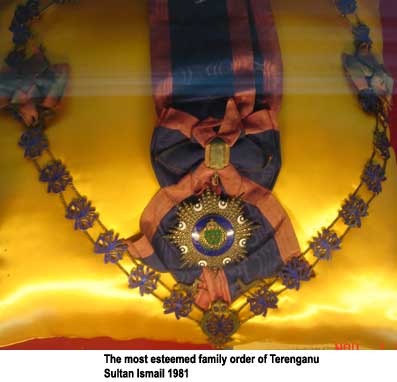
This has been incorrectly labelled. It should be the Most Illustrious Order of
the Crown of Kelantan, or the Star of Muhammad (Darjah Kebesaran Mahkota
Kelantan Yang Amat Mulia, Bintang al-Muhammadi): Knight Grand Commander or Dato'
Sri Paduka-SPMK, collar, sash and breast star.
0 -
A few more IDS
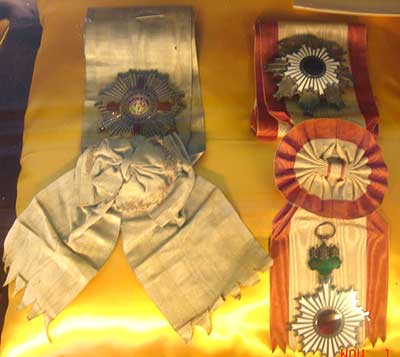
GCMG breast star on incorrect sash ribbon (left) and the Order of the Rising Sun of Japan, First class, breast star and sash badge (right)
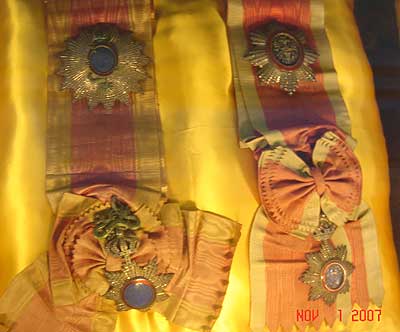
The Order of the Dragon of Annam, Grand Cordon, breast star and sash badge (left) and the Royal Order of Cambodia, Grand Cordon, breast star and sash badge (right)
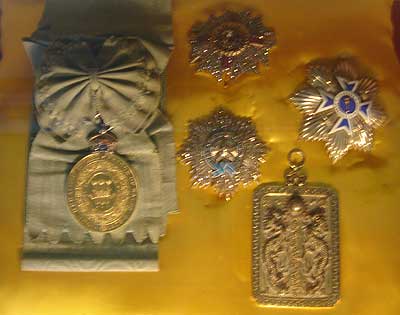
Bottom far left: the Imperial Order of the Double Dragon of China, First class, First grade - sash with the Prince of Wales's Gold Medal incorrectly in the place of the sash badge (the actual sash badge is shown bottom far right).Top: GCMG breast star with KCSI breast star
immediately below.Top far right: the Most Noble Order of Kamehameha I (Kamehameha I e Hookanaka), Knight Grand Cross breast star.

Top far left: the Most Noble Order of Kamehameha I (Kamehameha I e Hookanaka), Knight Grand Cross sash badge.
Top far right: the Order of the Crown of Italy, Grand Cross breast star.
Bottom: the Order of the Crown of Italy, badges of a Commander and Knight Grand Cross either side of a Grand Cross sash ribbon.
0 -
A few more identifications, where possible.
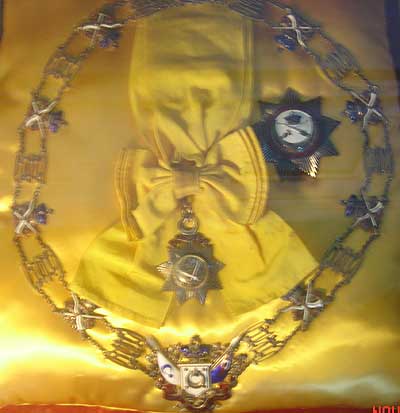
The Most Illustrious Order of the Crown of Johore (Darjah Mahkota Johor Yang
Amat Mulia). Knight Grand Companion SPMJ
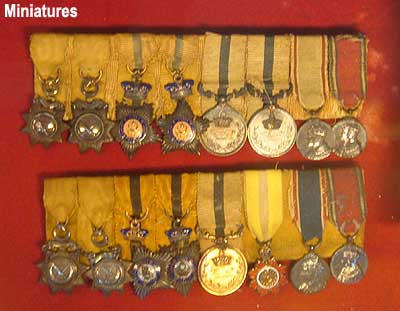
Top row, left to right: The Most Esteemed Family Order of Johore (Darjah Kerabat
Johor Yang Amat di-Hormati) first class (1) and second class (2), The Most
Illustrious Order of the Crown of Johore (Darjah Mahkota Johor Yang Amat Mulia)
first class (3) and third class (4), Sultan Abu Bakar Medal (Pingat Abu Bakar
Sultan) first class (5) and second class (6), King George V Silver Jubilee Medal on wrong ribbon (7) and King George VI Coronation Medal (8).
Second row, left to right: The Most Esteemed Family Order of Johore (Darjah Kerabat
Johor Yang Amat di-Hormati) first class (1) and second class (2), The Most
Illustrious Order of the Crown of Johore (Darjah Mahkota Johor Yang Amat Mulia)
first class (3) and third class (4), Sultan Abu Bakar Medal (Pingat Abu Bakar
Sultan) first class (5), unknown (6), King George V Silver Jubilee Medal on wrong ribbon (7) and King George VI Coronation Medal (8).
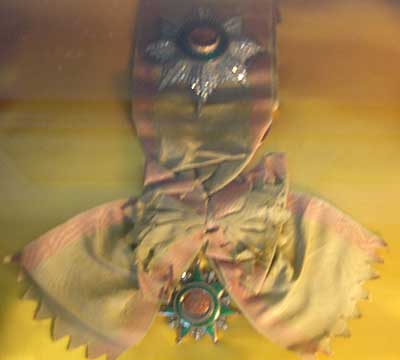
Nishan-i-Osmanieh (the Imperial Order of the Osmans) 1st class of Turkey, breast
star and sash badge.
0


Bhutan
in South Asia
Posted
Here is some further information on Bhutanese awards that I have been able to gather so far. Not a lot, but something to start with anyway. The awards are listed according to precedence as seen from the post nominals used by senior Bhutanese military officers.
The Royal Order of Bhutan: founded by King Jigme Dorji Wangchuk in 1966. Awarded in three classes and one medal.
Druk Wangyel (Great Victory of the Thunder Dragon): instituted by King Jigme Singye Wangchuck in 1985 as the country?s highest national award (postnominal=DWG). There is mention of this award to Rajiv Gandhi but I have seen a picture of him receiving the Royal Order of Bhutan from the 4th King, so it is quite possible that this may be the same as the above??
Druk Yuelgyel (Victory of the Thunder Dragon): described as 'the highest military medal of honour' and awarded for outstanding acts of dedication, loyalty and commitment by an individual or units of the Royal Bhutan Army, Royal Bodyguard, National Militia, Royal Bhutan Police, and Forest Guards (postnominal=DYG).
Druk Thuksey (Son of the Heart of the Thunder Dragon): instituted by King Jigme Singye Wangchuck on 2nd June 1999 as the highest individual civilian decoration and awarded for outstanding services to ?Tsa-Wa-Sum?, the king, country and the people.
Drakpoi Wangyel: medal of honour awarded to members of the Royal Bhutan Army and the Royal Bhutan Police (post nominal=DW).
Drakpoi Thuksey: a meritorious service medal awarded to members of the Royal Bhutan Army, Royal Bodyguard, National Militia, Royal Bhutan Police, and Forest Guards and the uniformed civilian services to reward services to maintaining national security (post nominal=DT).
Drakpoi Khorlo: a meritorious service medal awarded to members of the Royal Bhutan Police and to reward services to maintaining law and order (post nominal=DK).
Cheers
James